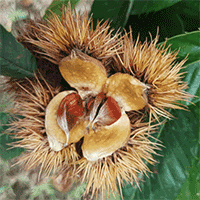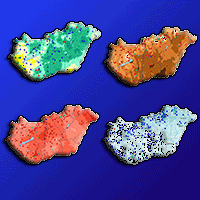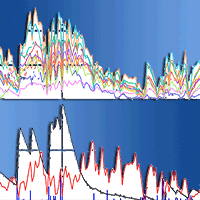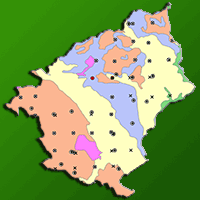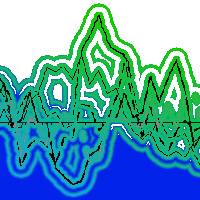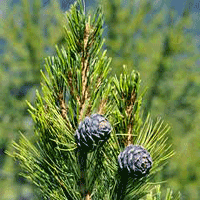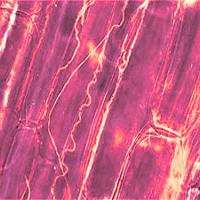
Endophytes in changing environments - do we need new concepts in forest management?
D Krabel (1) , K Morgenstern (1), S Herzog (2)
iForest - Biogeosciences and Forestry, Volume 6, Issue 3, Pages 109-112 (2013)
doi: https://doi.org/10.3832/ifor0932-006
Published: Mar 05, 2013 - Copyright © 2013 SISEF
Short Communications
Abstract
The occurrence of endophytic fungi, hosted by living tissues of forest trees seems to be a common phenomenon. Numerous studies show that these colonists are mostly symptomless or even live in a symbiotic relationship to the host plant. Our investigations on Douglas-fir and Rhabdocline needlecast show that Rhabdocline pseudotsugae (Sydow), which has been described exclusively as an obligatory needle pathogen up to now, is able to persist symptomless in different types of plant tissues and therefore an endophytic lifestyle has to be assumed. Whether this lifestyle is part of the infection strategy of the fungus is still unclear. However, examples of other wood associated fungi lead us to the hypothesis that environmental such as climate conditions are able to trigger the phenomenon of changing from a mutualist to a virulent parasite.
Keywords
Douglas-fir, Endophytes, Rhabdocline Needlecast, Climate Change
Authors’ Info
Authors’ address
K Morgenstern
Molecular Physiology of Woody Plants Group, Dresden University of Technology, Pienner Str. 7, D-01737 Tharandt (Germany)
Institute of Silviculture and Forest Protection, Dresden University of Technology, Pienner Str. 8, D-01737 Tharandt (Germany)
Corresponding author
Paper Info
Citation
Krabel D, Morgenstern K, Herzog S (2013). Endophytes in changing environments - do we need new concepts in forest management?. iForest 6: 109-112. - doi: 10.3832/ifor0932-006
Academic Editor
Marco Borghetti
Paper history
Received: Dec 17, 2012
Accepted: Feb 05, 2013
First online: Mar 05, 2013
Publication Date: Jun 01, 2013
Publication Time: 0.93 months
Copyright Information
© SISEF - The Italian Society of Silviculture and Forest Ecology 2013
Open Access
This article is distributed under the terms of the Creative Commons Attribution-Non Commercial 4.0 International (https://creativecommons.org/licenses/by-nc/4.0/), which permits unrestricted use, distribution, and reproduction in any medium, provided you give appropriate credit to the original author(s) and the source, provide a link to the Creative Commons license, and indicate if changes were made.
Web Metrics
Breakdown by View Type
Article Usage
Total Article Views: 57485
(from publication date up to now)
Breakdown by View Type
HTML Page Views: 47657
Abstract Page Views: 3281
PDF Downloads: 4912
Citation/Reference Downloads: 21
XML Downloads: 1614
Web Metrics
Days since publication: 4691
Overall contacts: 57485
Avg. contacts per week: 85.78
Citation Metrics
Article Citations
Article citations are based on data periodically collected from the Clarivate Web of Science web site
(last update: Mar 2025)
Total number of cites (since 2013): 9
Average cites per year: 0.69
Publication Metrics
by Dimensions ©
Articles citing this article
List of the papers citing this article based on CrossRef Cited-by.
References
Preliminary studies on endophytic fungal communities of Musa acuminata species complex in Hong Kong and Australia. Fungal Diversity 1: 27-51.
Gscholar
The biology of endophytism in plants with particular reference to woody perennials. In: “Microbiology of the Phyllosphere” (Fokkema NJ, Dem Heuvel J eds). Cambridge University Press, Cambridge, UK, pp. 205-222.
Gscholar
Development and testing of oligonucleotide probes for detection and identification of some fungal pathogens and endophytes of conifers. PhD thesis, Department of Plant Pathology, Michigan State University, East Lansing, MI, USA, pp. 399.
Gscholar
A rapid DNA isolation procedure for small quantities of fresh leaf tissue. Phytochemistry Bulletin 19: 11-15.
Gscholar
Pflanzliche Infektionslehre (2 edn). Birkhäuser, Basel, Switzerland, pp. 681.
Gscholar
Comparative genome analysis provides insights into the evolution and adaptation of Pseudomonas syringae pv. aesculi on Aesculus hippocastanum. PLoS ONE 5 (4): e10224.
CrossRef | Gscholar
Ainsworth and Bisby’s dictionary of Fungi. Cambridge University Press, CAB International, UK.
Gscholar
Ainsworth and Bisby’s dictionary of the Fungi. CAB International, Oxon, UK.
Gscholar
Die Krankheiten der Douglasie. In: “Die Douglasie und ihr Holz” (Göhre K eds). Akademie Verlag, Berlin, Germany, pp. 369-401.
Gscholar
Rhabdocline needle cast - Investigations on various Douglas-fir tissue types. European Journal of Plant Pathology. [submitted]
Gscholar
Fungal endophytes in xylem of healthy Chilean trees and their possible role in early wood decay. Fungal Diversity 33: 77-86.
Gscholar
Fungal endophytes in tree leaves. In: “Microbial Ecology of Leaves” (Andrews JH, Hirano SS eds). Springer, New York, USA, pp. 179-197.
Gscholar
Endophytes of forest trees: a model for fungus-plant interactions. In: “The Mycota. V. Plant relationships. Part B” (Carroll GC, Tudzynski P eds). Springer-Verlag, Berlin, Germany, pp. 129-142.
Gscholar
Endophytic fungi. In: “Biodiversity of fungi. Inventory and monitoring methods” (Mueller GM, Bills GF, Foster MS eds). Elsevier, Amsterdam, the Netherlands, pp. 241-270.
Gscholar
Douglasienschütte Merkblätter der Forstlichen Versuchs- und Forschungsanstalt Baden Württemberg, Nr. 2. Verlag Paul Parey, Hamburg/Berlin, Germany.
Gscholar
Rhabdocline pseudotsugae Sydow, oorzak eener ziwekte van Douglasspar. Proefschrift, Landbouwhoogschool, Wageningen, the Netherlands, pp 168.
Gscholar
Die Waldzustandssituation 2005 in der Bundesrepublik Deutschland. Forst und Holz 60: 503-505.
Gscholar

